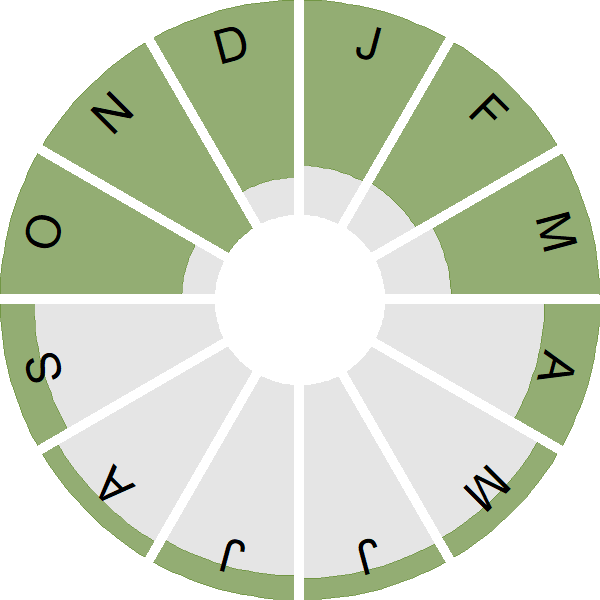Whooper Swan

Introduction
The Whooper Swan is a familiar winter visitor across much of Britain and Ireland, though is less commonly encountered in the more southern counties.
A large swan, with a triangular yellow bill patch, and a straight-necked look, the Whooper Swan has a more northerly wintering distribution within Britain & Ireland than its smaller relative. An increase in the Icelandic breeding population is thought to be behind the increasing numbers reported by the Wetland Bird Survey and evident in latest atlas results.
There are few records of Whooper Swans breeding in the UK, although Bird Atlas 2007–11 recorded successful breeding in south-east England, Northern Ireland and Scotland. Whilst some birds probably originate from captive stock, the Shetland breeding records indicate an expansion of the arctic population.

Key Stats
Identification
ID Videos
This section features BTO training videos headlining this species, or featuring it as a potential confusion species.
Wild Swans
Songs and Calls
Call:
Status and Trends
Conservation Status
Population Change
The Whooper Swan is predominantly a winter visitor to the UK with wintering numbers increasing in line with increases in the Icelandic breeding population (link to WeBS; Brides et al. 2021). It is a scarce breeding species for which numbers are monitored by the RBBP. Numbers have increased strongly over the 25 years to 2019 with around 30 pairs now breeding, mostly in Scotland (Eaton et al. 2021).
Distribution
The general pattern of winter distribution of the Whooper Swan remains consistent with the 1981–84 Winter Atlas, with the largest numbers of occupied squares in more northerly areas of both Britain and Ireland. There are relatively few records of breeding Whooper Swans in Britain and Ireland. The map of breeding distribution shows confirmed records in southeast England, the northern part of Ireland and Scotland. Some are known to stem from injured birds remaining to summer and breed but confirmed records on Shetland and the Outer Hebrides, could reflect an expansion in the species breeding range.
Occupied 10-km squares in UK
or view it on Bird Atlas Mapstore.
or view it on Bird Atlas Mapstore.
European Distribution Map
Distribution Change
The winter change map shows that much of the central and north central areas in Ireland, and south and central Scotland, remained occupied during both winter atlases. Some range expansion in southern areas is evident, particularly in southeast England. Range increases of 35% and a 16% were identified in Britain and Ireland respectively. These results are consistent with an increase in the Icelandic breeding population of the Whooper Swan, which winters exclusively in Britain & Ireland.
Change in occupied 10-km squares in the UK
or view it on Bird Atlas Mapstore.
or view it on Bird Atlas Mapstore.
Seasonality
Whooper Swans are most often seen in winter, but can occasionally be seen in the breeding season: some injured wintering birds remain to summer, and there is also a small northern breeding population.
Weekly pattern of occurrence
The graph shows when the species is present in the UK, with taller bars indicating a higher likelihood of encountering the species in appropriate regions and habitats.

Movement
Britain & Ireland movement
Foreign locations of birds ringed or recovered in Britain & Ireland
Dots show the foreign destinations of birds ringed in Britain & Ireland, and the origins of birds ringed overseas that were subsequently recaptured, resighted or found dead in Britain & Ireland. Dot colours indicate the time of year that the species was present at the location.
- Winter (Nov-Feb)
- Spring (Mar-Apr)
- Summer (May-Jul)
- Autumn (Aug-Oct)

European movements
EuroBirdPortal uses birdwatcher's records, such as those logged in BirdTrack to map the flows of birds as they arrive and depart Europe. See maps for this species here.
The Eurasian-African Migration Atlas shows movements of individual birds ringed or recovered in Europe. See maps for this species here.
Biology
Productivity and Nesting
Nesting timing
Egg measurements
Clutch Size
Survival and Longevity
Survival is shown as the proportion of birds surviving from one year to the next and is derived from bird ringing data. It can also be used to estimate how long birds typically live.
View number ringed each year in the Online Ringing Report.
lifespan
Survival of adults
Biometrics
Wing length and body weights are from live birds (source).
Wing length
Body weight
Ring Size
Classification, names and codes
Classification and Codes
- Order: Anseriformes
- Family: Anatidae
- Scientific name: Cygnus cygnus
- Authority: Linnaeus, 1758
- BTO 2-letter code: WS
- BTO 5-letter code: WHOSW
- Euring code number: 1540
Alternate species names
- Catalan: cigne cantaire
- Czech: labut zpevná
- Danish: Sangsvane
- Dutch: Wilde Zwaan
- Estonian: laululuik
- Finnish: laulujoutsen
- French: Cygne chanteur
- Gaelic: Eala-fhiadhaich
- German: Singschwan
- Hungarian: énekes hattyú
- Icelandic: Álft
- Irish: Eala Ghlórach
- Italian: Cigno selvatico
- Latvian: ziemelu gulbis
- Lithuanian: gulbe giesmininke
- Norwegian: Sangsvane
- Polish: labedz krzykliwy
- Portuguese: cisne-bravo
- Slovak: labut spevavá
- Slovenian: labod pevec
- Spanish: Cisne cantor
- Swedish: sångsvan
- Welsh: Alarch y Gogledd
Research
Causes of Change and Solutions
Causes of change
The cause of the increase in breeding records is unclear. Some breeding records result from injured birds being unable to migrate back to Iceland, but others may reflect an expansion of the breeding range resulting from the growth of the Icelandic population (Balmer et al. 2013, Eaton et al. 2021). The population and range in Fennoscandia is also increasing, and the increases of both populations have been attributed to protection from hunting and the availability of agricultural land as a source of food during winter (Deinet et al. 2013, Eaton et al. 2021).

